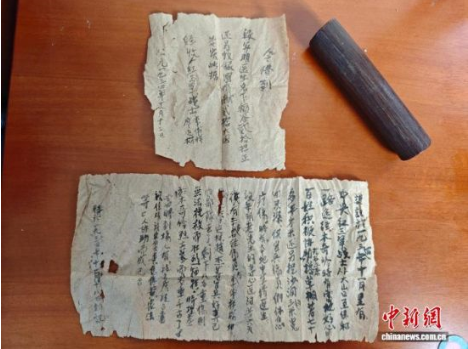Recently, a villager from Cailing Village of Liangtian Town, Suxian District, Chenzhou City found a well-preserved IOU (I Owe You) from the Red Army in his home. This note, written in 1934, reflects the deep bond of friendship between the Red Army and the people during the warring years.

According to the “History of Revolutionary Struggle in Chenxian County”, on November 11, 1934, one division of the Central Red Third Army rested in today’s Cailing Village.
It was a cold winter and supplies were extremely scarce. However, the highly disciplined soldiers in the Red Army took nothing from the masses and did not commit the slightest offence against the people, which deeply moved the local people.
Rural doctor Duan Nianming voluntarily lent about 1,000 kg of rice, donated twenty silver dollars, and led his family and villagers to collect medicinal herbs for the wounded and sick soldiers for six consecutive days.
Cao Yong, director of the Party History Research Office of Suxian District Committee, introduced: “We organized personnel to revisit the route the Red Army walked past during the Long March in Chenxian County. Through visits to local villagers, combined with the records of the revolutionary history of Chen County, it can be found that at that time, the local governments, the Red Army troops, and the local guerrillas attached great importance to the Red Army's stayover, and held meetings overnight to deploy the work of welcoming and seeing off the Red Army. The local people also gave active support, not only building grass sheds and making grass shoes for the Red Army, but also offering some food. Among them, the village doctor Duan Nianming, who was known for his kindness, was specifically responsible for treating injured and sick soldiers.”
Before the army left, the soldiers wrote an IOU and handed it over to Duan Nianming, promising to return the money after the victory of the revolution. Since then, this note has been treasured by the Duan family.
In Cailing Village, local villagers treated more than 30 wounded and sick soldiers at that time, and more than 20 of them continued their way westward after recovery, but 8 soldiers died due to severe injuries.
The local people donated their own wood to make simple coffins and buried them. Today, local villagers still sweep these tombs and offer sacrifices every year.
According to the records, during the Central Red Army passing through Chenxian County in 1934, they had extensive contact with more than 120,000 local people. The Chenxian County Party Committee organized local people to prepare 60,000 kilograms of grain for the Red Army, made more than 28,000 pairs of grass shoes, and treated 417 injured soldiers.
Cao Yong said, “This IOU records the touching story between the Red Army and the local people, and also reflects the deep affection between them. We must continue to tell the story of the Red Army well, carry forward the spirit of the Red Army, and inherit the red genes.”
Chinese source: chinanews







 湘ICP备13003667号
湘ICP备13003667号
